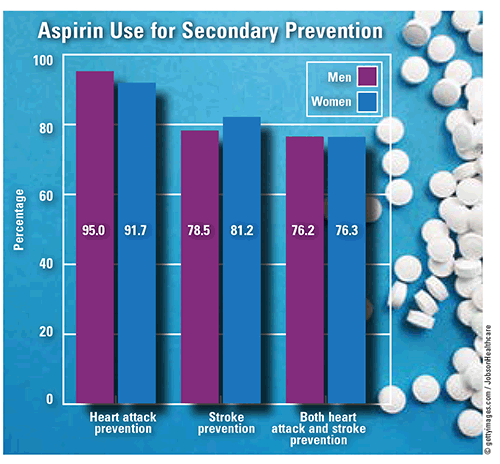US Pharm. 2019;44(2):36.
According to the CDC’s Behavioral Risk Factor Surveillance System 2013, 70.8% of adults with atherosclerotic cardiovascular disease (ASCVD) use aspirin regularly. Among ASCVD patients, aspirin was used more frequently for heart attack prevention (93.6%) than for stroke prevention (79.6%), and 76.2% used aspirin to prevent both heart attack and stroke. Aspirin use was documented in 54% of outpatient visits for ischemic vascular disease and in 98% of hospital discharges for acute coronary syndrome.

Cardiovascular Risk Factors: At least one of the three key cardiovascular (CV) risk factors for heart disease (i.e., high blood pressure, high cholesterol, and smoking) is present in 47% of adults. Regular use of aspirin for secondary prevention was more common in patients with three CV risk factors (76.1%) than in those with four, two, one, or zero risk factors (72.7%, 74.5%, 63.4%, and 54.7%, respectively). When aspirin was used for heart attack prevention, its use declined with decreasing number of comorbidities (97.1%, 95.9%, 93.8%, and 90.5%, respectively, for four, three, two, and one CV risk factor). Although aspirin use was less common for stroke prevention than for heart attack, a similar trend was seen for four, three, two, one, and no risk factors (84.2%, 81.8%, 79.7%, 77.3%, and 72.6%, respectively).
Demographics: Nearly 71% of adults with ASCVD used aspirin regularly, and aspirin use was higher in those aged 65 years and older than in those aged 18 to 64 years (75% vs. 65.9%). Persons aged 65 years and older used aspirin more often for heart attack prevention than for stroke prevention (94.2% vs. 78.6%). In patients aged 18 to 64 years, aspirin was used more often to prevent stroke than to prevent heart attack (92.9% vs. 80.8%). However, the difference in aspirin use for prevention of both heart attack and stroke in persons aged 18 to 64 years and those aged 65 years and older was marginal (77.2% vs. 75.4%). Men more often used aspirin to prevent heart attack (95%) than to prevent stroke (78.5%). More women than men (81.2% vs. 78.5%) took aspirin to prevent stroke, and more men than women (95% vs. 91.7%) took it to prevent heart attack.
Prevention of Both Heart Attack and Stroke: Aspirin was used as a preventive measure against both heart attack and stroke by 76.2% of adults, with 2.3% more use among persons aged 18 to 64 years (77.2%) than in those aged 65 years and older (75.4%). Rates of use as a preventive strategy were similar between men and women (76.2% vs. 76.3%).
To comment on this article, contact rdavidson@uspharmacist.com.






